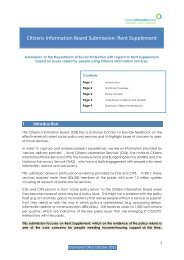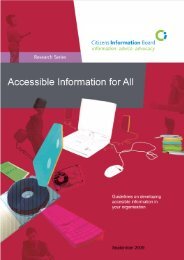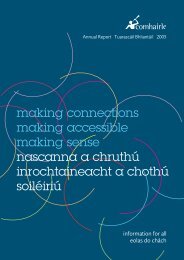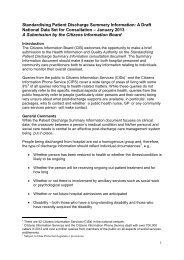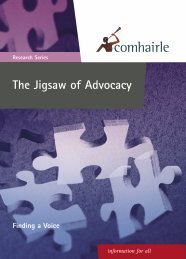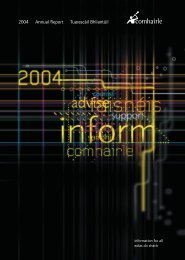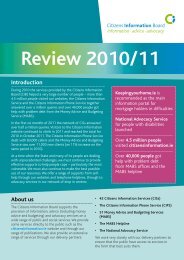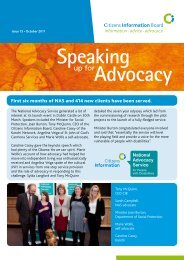Review of Sign Language Interpretation Services and Service ...
Review of Sign Language Interpretation Services and Service ...
Review of Sign Language Interpretation Services and Service ...
- No tags were found...
You also want an ePaper? Increase the reach of your titles
YUMPU automatically turns print PDFs into web optimized ePapers that Google loves.
5.5.2 Interpreter training courses <strong>and</strong> qualificationsWith the establishment <strong>of</strong> pr<strong>of</strong>essional associations <strong>of</strong> interpreters, there was aneed to identify who could join <strong>and</strong> what constituted a sign language interpreter.Once pr<strong>of</strong>essional training courses were established, it became easier to decidethat those who had successfully completed a programme <strong>of</strong> interpreter trainingcould become recognised as bona fide interpreters. This is the point that most <strong>of</strong>the countries have reached. In New Zeal<strong>and</strong>, for example, the first <strong>and</strong> onlyformal interpreter training programme was set up in 1992. In Scotl<strong>and</strong> there isone interpreter training programme at Heriot Watt University. This part-timecourse is the equivalent <strong>of</strong> one year's undergraduate study.In Engl<strong>and</strong> the first two university courses were established in the late 1980s.There are now five programmes provided by four universities: three are at degreelevel <strong>and</strong> two at post-graduate or masters level. These programmes currentlyserve Engl<strong>and</strong>, Wales <strong>and</strong> Northern Irel<strong>and</strong>. The degree level courses enable oneto achieve the first level <strong>of</strong> qualification as an interpreter but it is not until a postgraduatequalification has been achieved that one becomes a fully qualifiedinterpreter. In Engl<strong>and</strong>, one can also achieve this status through the vocationalroute <strong>of</strong> the Level 4 National Vocational Qualification in Interpreting (BSL/English).In Finl<strong>and</strong>, there are two institutions that each <strong>of</strong>fer a four-year full-timeundergraduate degree, <strong>and</strong> also administer the interpreter competency test,which is the gateway to registration. In Denmark, there is a 3.5 year course forsign language interpreters running in two centres. This was previously a 300 hourcourse <strong>and</strong> then a 2 year course.In New Zeal<strong>and</strong> there is currently only one interpreter training course <strong>and</strong> that isat the Auckl<strong>and</strong> University <strong>of</strong> Technology (AUT). The course is 2 year full-time,running from February to November each year. At the end <strong>of</strong> the programmestudents receive a Diploma in <strong>Sign</strong> <strong>Language</strong> Interpreting.Despite improved training opportunities for interpreters, there is some evidencethat there has been, <strong>and</strong> continues to be, considerable wastage from those alreadytrained <strong>and</strong> qualified. Research to support this evidence <strong>and</strong> to identify reasonsfor the wastage (such as burnout <strong>and</strong> career progression into other posts) hasbeen conducted by the RNID <strong>and</strong> ASLI in Engl<strong>and</strong>. One implication <strong>of</strong> wastage isthat those responsible for planning to increase the number <strong>of</strong> interpreters shouldtake account <strong>of</strong> this when estimating requirements.Given the shortage <strong>of</strong> interpreters in most <strong>of</strong> the countries studied, a need forfunding for training <strong>and</strong> support has been recognised. The Scottish Executive hasrecently provided £350,000 for a course to train trainers <strong>of</strong> BSL <strong>and</strong> BSL/Englishinterpreting. This has arisen from an acknowledgement that the capacity forteaching BSL <strong>and</strong> sign linguistics needs to be addressed in parallel with theestablishment <strong>of</strong> interpreter training. A similar approach has been taken inEngl<strong>and</strong> where the Department for Work <strong>and</strong> Pensions, between 2004 <strong>and</strong> 2005,invested £1.5 million in the development <strong>of</strong> training programmes <strong>and</strong> resourcesfor BSL teachers <strong>and</strong> in raising awareness <strong>of</strong> the needs <strong>of</strong> BSL users.Achieving an interpreting qualification is an indicator that the interpreter hasachieved a particular st<strong>and</strong>ard both in sign language <strong>and</strong> in sign languagepage 102 • <strong>Review</strong> <strong>of</strong> <strong>Sign</strong> <strong>Language</strong> <strong>Interpretation</strong> <strong><strong>Service</strong>s</strong> <strong>and</strong> <strong>Service</strong> Requirements in Irel<strong>and</strong>



